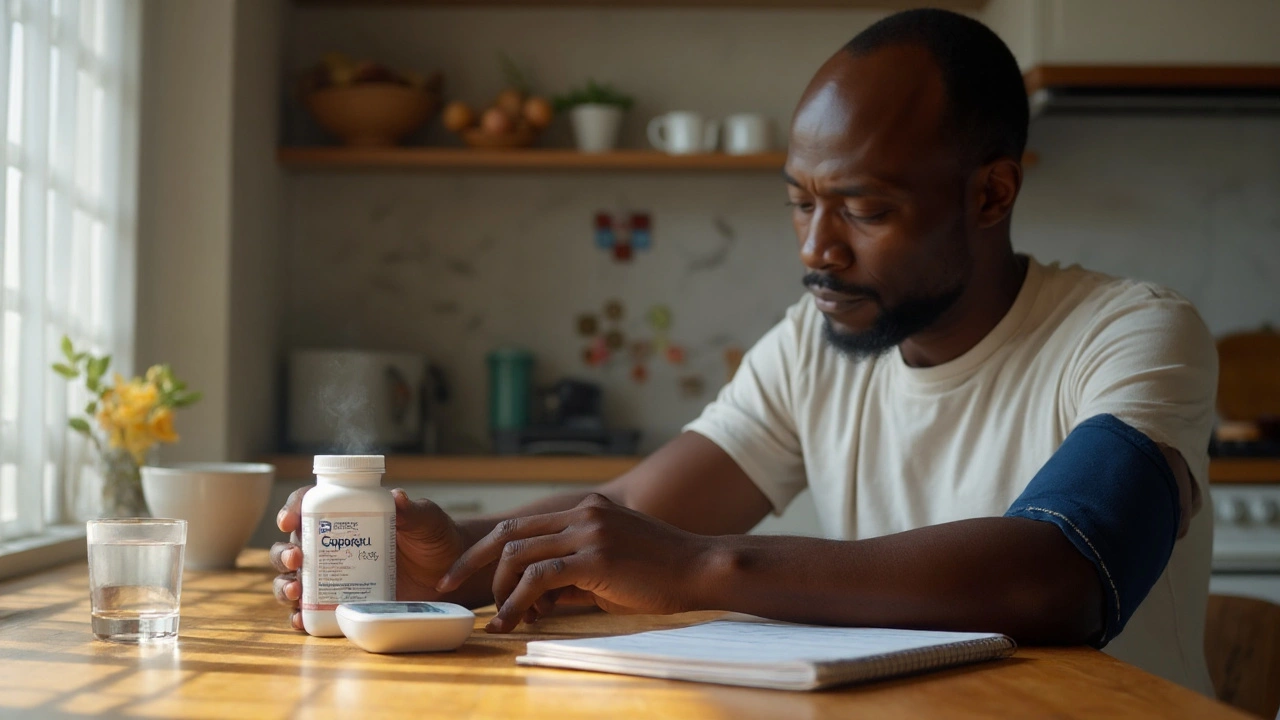You came here to answer four blunt questions: what this pill does, how to take it so it actually works, what side effects to expect, and how to get it in the UK without getting burned by shortages or hype. That’s the promise. The reality? Rybelsus (oral semaglutide) can drop HbA1c and help with weight in adults with type 2 diabetes, but it’s not a magic weight-loss drug, and timing your tablet matters more than people think. I’ll keep it simple, practical, and UK‑specific.
- TL;DR: It’s an oral GLP‑1 medicine for type 2 diabetes. Start 3 mg daily for 30 days, then 7 mg; some go to 14 mg. Take on an empty stomach with a little water, then wait 30 minutes before any food, drink, or other meds.
- Expect nausea early; eat smaller portions, go easy on grease, hydrate. Watch for warning signs like severe abdominal pain (pancreatitis). Don’t use in pregnancy or if you have MEN2/medullary thyroid cancer history.
- Weight loss happens for many, but it’s not licensed for weight management in the UK. For weight loss, the licensed brand is Wegovy (injectable semaglutide).
- UK access in 2025: NHS use follows NICE guidance and supply triage; private supply varies. Don’t buy from social media or unknown sellers.
What Rybelsus is, who it’s for, and what to expect
Rybelsus is the tablet form of semaglutide, a GLP‑1 receptor agonist. Translation: it mimics a gut hormone that helps your body release insulin when you eat, slows stomach emptying, and signals your brain that you’ve had enough. Blood sugar tends to fall, appetite eases, and weight can come down over time.
Who it’s for in the UK: adults with type 2 diabetes who need better glucose control. Clinicians often use it when metformin alone isn’t enough or isn’t tolerated, either as monotherapy (if metformin isn’t suitable) or alongside drugs like metformin, SGLT2 inhibitors, or insulin. It’s not for type 1 diabetes. It’s not a first‑line weight‑loss medicine, and it’s not licensed for obesity in the UK.
What the evidence says: across the PIONEER clinical trials, people on oral semaglutide generally saw meaningful A1c reductions (often around 1 percentage point or more from baseline) and modest weight loss. Results vary with dose and background therapy. These are solid diabetes outcomes. For heart protection, injectable semaglutide has proven benefit; for the tablet, outcome data have been emerging, and practice will follow regulator guidance as it updates. Your clinician will know the latest.
Common benefits people notice: fewer glucose spikes after meals, smaller appetite, and a slow, steady weight drift downward if diet is consistent. The first few weeks are about getting used to the pill and finding a routine that fits your mornings.
Key safety points in plain English:
- Don’t use it if you or a close family member ever had medullary thyroid cancer, or if you have MEN2. This is a red‑flag contraindication on the UK label.
- Call for urgent help if you have severe, persistent stomach pain (possible pancreatitis), or if you notice yellowing of the skin/eyes (gallbladder or liver issues).
- If you use insulin or a sulfonylurea (like gliclazide), you can go low. Monitor glucose and ask about dose adjustments.
- Pregnancy and breastfeeding: avoid. If you’re planning a pregnancy, discuss stopping well ahead of time. Semaglutide hangs around for weeks.
| Item | What to know (Rybelsus) |
|---|---|
| Active ingredient | Semaglutide (oral tablet with absorption enhancer SNAC) |
| Strengths | 3 mg, 7 mg, 14 mg |
| Usual titration | 3 mg once daily for 30 days → 7 mg once daily; may increase to 14 mg if more glucose lowering needed |
| How to take | Empty stomach, with up to 120 mL (4 oz) plain water; swallow whole; wait ≥30 minutes before any food, drink, or other oral meds |
| Half‑life | About 1 week; steady state in ~4-5 weeks |
| Missed dose | Skip and take next day as usual; don’t double up |
| Common side effects | Nausea, diarrhoea, vomiting, stomach pain, constipation, headache, decreased appetite |
| Serious but rare | Pancreatitis, gallbladder issues, kidney injury (often from dehydration), possible worsening diabetic retinopathy if glucose drops fast |
| Not for | Type 1 diabetes, pregnancy, breastfeeding, history of medullary thyroid carcinoma or MEN2 |
| Interactions to flag | Insulin/sulfonylureas (hypoglycaemia risk), levothyroxine (monitor), warfarin (check INR), any meds where absorption timing really matters |
Why the empty‑stomach rule matters: oral semaglutide’s absorption is tiny to begin with. Food or coffee too soon can wipe it out. If your timing is sloppy, your results will be too.

How to take it right, minimise side effects, and stay safe
The most common reason people “fail” this med is easy: the dose was fine, but the routine wasn’t. Nail the routine first; adjust the dose later.
Simple morning routine that works:
- Wake up and take your tablet with a small glass of plain water (no fizzy, no flavoured). Aim for 50-120 mL.
- Set a 30‑minute timer. Don’t eat, don’t sip coffee, and don’t take other pills in that window.
- After 30 minutes, have breakfast and take the rest of your morning meds.
- Keep it at the same time daily. If you wake at odd hours (shift work), tie it to “waking up”, not the clock.
Dose plan most adults follow (your clinician may tweak this):
- Days 1-30: 3 mg once daily to let your gut adapt.
- From day 31: 7 mg once daily.
- If A1c still high after at least 4-8 weeks at 7 mg, consider 14 mg once daily.
What to expect in the first 12 weeks:
- Week 1-2: Nausea can pop up, especially if you eat large or greasy meals. Appetite often dips. Some people feel burpy or bloated.
- Week 3-4: Stomach settles for many. Blood sugars after meals improve. If still rough, stay longer on 3 mg before stepping up.
- Week 5-8: You’re likely on 7 mg now. Appetite and weight trends become clearer. Adjust other diabetes meds if lows creep in.
- Week 9-12: If control still isn’t where you want it and side effects are manageable, your clinician may move you to 14 mg.
Side‑effect survival guide:
- Eat smaller portions; add protein to each meal.
- Go easy on fatty, fried, or very spicy foods during titration.
- Sip water through the day; aim for pale urine. Dehydration makes nausea worse.
- Ginger tea, dry crackers, or peppermint can help queasiness.
- If vomiting or diarrhoea persist more than a couple of days, call your clinician. You may need to pause or step back a dose.
When to get urgent help:
- Severe, persistent stomach pain sometimes moving to your back (pancreatitis).
- Yellow skin/eyes, pale stools, dark urine (possible gallbladder or liver issues).
- Signs of dehydration you can’t correct (dizziness, very low urine output).
Drug and condition interactions to think about:
- Insulin or sulfonylureas (like gliclazide): higher risk of hypos. Ask about dose reductions once semaglutide starts working.
- Levothyroxine: semaglutide can change absorption. Take Rybelsus first, then your levothyroxine after the 30‑minute window. Your GP may check TSH after changes.
- Warfarin: extra INR checks when you start or change dose.
- Oral contraceptives: no formal dose change needed, but if you’re vomiting or have bad diarrhoea, use backup contraception.
- Diabetic retinopathy: if your A1c falls fast and you have existing retinopathy, get eye checks. Report vision changes quickly.
Alcohol and driving:
- Moderate alcohol is usually fine, but heavy drinking increases pancreatitis risk and can mess with glucose control.
- On Rybelsus alone, hypos are uncommon. Add insulin or a sulfonylurea and the risk goes up-don’t drive if you feel hypo. Keep glucose tabs handy.
Missed dose, sick day rules, and other “what ifs”:
- Missed today’s pill? Skip it. Take the next dose tomorrow at your usual time.
- Threw up soon after taking it? Don’t re‑dose. Resume tomorrow.
- Sick day: if you can’t keep fluids down, stop diabetes meds that raise dehydration risk, sip oral rehydration solution, and seek advice. Check glucose and ketones if you can.
When to check labs and targets:
- A1c: recheck around 12 weeks after you’re stable on your current dose.
- Kidney function and electrolytes if vomiting/diarrhoea dragged on.
- Set personalised glucose targets with your clinician (NICE encourages individualised goals).
Storage and handling:
- Keep in the original blister until use, at room temperature, away from moisture.
- Don’t split, crush, or chew the tablet. Swallow whole.
Pro tip if mornings are chaotic: keep the blister pack and a small cup by your toothbrush. Take the pill first, brush, shower, dress-by then your 30 minutes are up.

UK 2025 access, comparisons, cost realities, and your next steps
Access in the UK this year is a mixed picture: strong demand, ongoing supply tightness, and clear rules on what’s licensed for what.
NHS access:
- Prescribing follows NICE guidance for type 2 diabetes. Expect prioritisation for those most likely to benefit, especially while supply is tight.
- Clinicians avoid off‑label weight‑loss use with Rybelsus; that’s not what it’s licensed for.
- Supply updates shift month to month. Your GP or practice pharmacist will know the current stance in your area.
Private access:
- Legit UK pharmacies may supply with a valid private prescription, but availability changes. Prices vary by strength and supplier.
- Red flags: online “no‑prescription” offers, social media sellers, or unusually low prices. Counterfeits are a real risk-don’t gamble with a GLP‑1.
Weight loss expectations and reality:
- Many people lose weight on the 7-14 mg dose when they eat smaller portions and stick with it. It tends to be slow and steady.
- For obesity without diabetes, the licensed semaglutide product is Wegovy (weekly injection). Different dose, different license.
| Medicine | How you take it | UK license (2025) | Typical use | Weight effect | Notes |
|---|---|---|---|---|---|
| Rybelsus (oral semaglutide) | Daily tablet, empty stomach | Type 2 diabetes | Lower glucose; weight often falls | Modest to moderate | Strict timing rules; not licensed for obesity |
| Ozempic (semaglutide injection) | Weekly injection | Type 2 diabetes | Lower glucose; CV benefit shown | Moderate | Different route; widely used, supply can vary |
| Wegovy (semaglutide 2.4 mg) | Weekly injection | Chronic weight management | Obesity/overweight with risk factors | High | Not a diabetes license; separate criteria |
| Metformin | Daily tablets | Type 2 diabetes | First‑line for most | Neutral to small loss | GI side effects common at start |
| SGLT2 inhibitors | Daily tablets | Type 2 diabetes, some CKD/HF | Glucose, heart, and kidney benefits | Small loss | Genital infections risk; good combo partner |
| DPP‑4 inhibitors | Daily tablets | Type 2 diabetes | Modest glucose drop | Neutral | Well‑tolerated; less potent on weight |
| Tirzepatide (Mounjaro) | Weekly injection | Type 2 diabetes; obesity license evolving | Strong glucose and weight effects | High | Access and criteria vary with supply |
Who Rybelsus is best for:
- Adults with type 2 diabetes who want a pill, not an injection, and can commit to the empty‑stomach routine.
- People needing A1c reduction plus some weight help.
- Those with cardiovascular risk who can’t access or don’t want injectables-though your clinician may prefer injectables if heart protection is the priority.
Who it’s not for:
- Anyone seeking a weight‑loss drug without diabetes-use licensed obesity treatments instead.
- People who can’t do the 30‑minute no‑food rule most mornings.
- Pregnant or breastfeeding people, or those with MEN2/medullary thyroid cancer history.
Quick checklist before you start:
- Do I understand the empty‑stomach rule and can I stick to it most days?
- Am I on insulin or a sulfonylurea that might need a dose change?
- Do I take levothyroxine, warfarin, or other pills where timing matters?
- Have I got a plan for nausea (small meals, hydration, ginger) during the first month?
- Do I know the red‑flag symptoms that need urgent care?
Mini‑FAQ
- Can I cut the tablet? No-swallow it whole with a small amount of water.
- Can I have coffee in the 30 minutes? No. Water only in that window.
- What if I forget and drink water or eat at 20 minutes? Don’t repeat the dose. Carry on and try to be stricter tomorrow.
- Does it interact with PPIs like omeprazole? No routine dose change is recommended. Still take Rybelsus first on an empty stomach.
- How soon will my glucose improve? Many see changes within weeks, but full steady effect takes a month or two at a stable dose.
- Will I regain weight if I stop? Likely some. That’s why nutrition, movement, and sleep matter alongside medication.
Credible sources your clinician will recognise: the MHRA Summary of Product Characteristics (SmPC) for Rybelsus (Novo Nordisk), NICE guidance for type 2 diabetes in adults (NG28) and related technology appraisals, and the PIONEER clinical trial programme for oral semaglutide. Ask your GP or pharmacist to walk through how these apply to you.
Next steps
- If you’re on metformin and still above your A1c target: book a medication review to discuss GLP‑1s and SGLT2s based on your risks and preferences.
- If you’re needle‑averse: talk through pill vs injection pros/cons. Be honest about your mornings and whether the 30‑minute wait will actually happen.
- If you’re already on insulin or a sulfonylurea: agree on a hypo plan and possible dose changes before you start.
- If you take levothyroxine: plan your morning timing and ask about checking TSH after you’re stable.
- If supply is tight locally: ask about alternatives (e.g., SGLT2 add‑on, injectable GLP‑1 if available) and when to review.
Troubleshooting by scenario
- New to type 2 diabetes: don’t skip metformin unless you truly can’t tolerate it. It’s still the backbone. Add GLP‑1 or SGLT2 if you need more.
- Struggling with nausea: hold at the current dose a bit longer, or step back. Food choices matter more than you think for the first month.
- Shift worker: anchor the dose to “wake‑up”, not clock time. Keep one small water bottle by the bed and another in your bag.
- On multiple morning meds: Rybelsus first, then everything else after 30 minutes. Create a simple pill chart so you don’t double‑dose by accident.
- Plateaued weight: check your calorie creep (weekends, snacks, drinks). Small tweaks can restart progress.
Last thing: the best results I see come from people who treat the 30‑minute rule like brushing their teeth-non‑negotiable. Get that right, and the rest of the plan works a lot better.






Comments
19 Comments
Jessica Ainscough
Been on Rybelsus 7mg for 3 months. Nausea was brutal week 1-2, but sticking to tiny meals and ginger tea made it bearable. Now I barely think about food between meals. Lost 14 lbs without trying. The 30-min empty stomach rule? Non-negotiable. I set a phone alarm labeled 'NO FOOD UNTIL 30' and it saved my progress.
Sara Larson
YESSSS this is the most practical guide I’ve read 😭 I was about to give up until I read the morning routine. Now I keep my blister pack next to my toothbrush and BAM - 30 mins later I’m sipping coffee like a boss. No more guesswork. Thank you 🙏
May .
Why does everyone act like this is magic when it’s just another drug with side effects
Josh Bilskemper
Oral semaglutide is a marketing ploy disguised as innovation. The absorption rate is pathetic compared to injections. Novo Nordisk knows this. They’re pushing Rybelsus because it’s cheaper to produce than Wegovy and they know people will pay more for a pill. Don’t fall for the placebo effect of convenience
Adrianna Alfano
Okay but why does no one talk about the UK supply chaos I’ve been through? My GP said ‘we’re rationing’ and I had to switch to metformin for 6 weeks. Then suddenly Rybelsus was back - no warning. I think they’re hiding how bad it is. And don’t even get me started on the private clinics charging £300 for a 30-day supply. This is healthcare exploitation. I’m not even diabetic but I know people who are desperate and getting scammed
Katey Korzenietz
People taking this for weight loss are delusional. It’s not licensed for that in the UK. You’re gambling with your health for vanity. Shame on you
Storz Vonderheide
Just wanted to add - if you’re on levothyroxine, take Rybelsus first, wait 30 mins, then your thyroid med. I missed this and my TSH went nuts. My endo had to adjust my dose. Simple fix, big difference. Also, if you’re a shift worker, tie it to waking up, not the clock. I work nights and I take it after my nap. Works fine.
dan koz
Bro I’m from Nigeria and I got mine from a guy on WhatsApp for 5000 naira. No prescription. Works fine. Why make it so complicated? People in the US overthink everything. Just take the pill. No 30 min rule needed. I eat right after. Still lost 10kg. Simple
Kevin Estrada
THEY’RE HIDING THE TRUTH. I found a leaked Novo Nordisk memo that says oral semaglutide is 78% less effective than injectables and they’re pushing it because it’s easier to get insurance to pay for. This is a corporate scam. People are dying from pancreatitis because they’re being misled. I’ve got screenshots. DM me if you want proof. This isn’t medicine - it’s a profit scheme
Ethan McIvor
It’s interesting how we treat medication like a moral test - either you’re disciplined enough to follow the 30-minute rule or you’re lazy. But what if you’re a single parent with a toddler who wakes up at 5am? What if your job doesn’t let you sit still? The system isn’t designed for real life. Maybe the problem isn’t the patient - it’s the rigid protocols
Mindy Bilotta
For anyone struggling with nausea - try frozen grapes instead of ginger tea. Cold and sweet tricks your stomach. Also, don’t stress if you eat at 25 mins. Just go back to the rule tomorrow. Progress not perfection. You got this
Michael Bene
Anyone else notice how the guide pretends this isn’t a weight-loss drug? The whole thing is a sugar-coated lie. They say it’s not licensed for obesity but then list weight loss as a benefit like it’s an accidental bonus. Wake up. This is GLP-1 capitalism. They’re selling hope wrapped in medical jargon. I’ve seen patients cry because they can’t afford Wegovy and are told ‘just take Rybelsus’ - like it’s the same thing. It’s not. And the NHS is complicit
Brian Perry
I took Rybelsus for 8 weeks. Lost 18 lbs. Then my insurance dropped it. Now I’m back on metformin. My appetite is back. My cravings are back. My jeans are back on. I feel like I’ve been emotionally gaslit. I didn’t ‘fail’ - the system failed me. This isn’t a pill. It’s a lifeline. And they’re pulling it away like it’s a luxury. What kind of world is this
Chris Jahmil Ignacio
People who take this without a diabetes diagnosis are selfish. You’re hoarding medication that people with actual metabolic disease need. You’re not ‘trying to be healthier’ - you’re chasing a TikTok body. This isn’t a diet. It’s a medical intervention. If you don’t have type 2 diabetes you don’t deserve this. End of story
Paul Corcoran
I get why some people are angry about access. But let’s not forget - this drug changed my life. I went from 200 lbs to 160. My A1c dropped from 8.2 to 5.8. I stopped taking insulin. I’m not perfect - I’ve missed doses. I’ve eaten too fast. But I kept trying. If you’re struggling, reach out. You’re not alone. And if you’re mad about supply - talk to your MP. Don’t let rage blind you to the real wins
Colin Mitchell
Just a quick tip - if you’re on warfarin, get your INR checked 2 weeks after starting Rybelsus. Mine dropped by 1.5 points. My anticoagulation clinic was shocked. They didn’t even know this interaction was possible. Always tell your pharmacist you’re on this. It’s not on most interaction checkers yet
kelly mckeown
I’m 68 and started this last year. My knees hurt less now. Not because I lost weight - though I did - but because my blood sugar is stable. No more 3pm crashes. No more brain fog. I don’t care about the hype. This gave me back my mornings. That’s enough.
Stacy Natanielle
According to the MHRA SmPC, the 14mg dose carries a 3.7% incidence of acute pancreatitis. Yet the post downplays this. The author is minimizing risk. This is medically irresponsible. Patients deserve full transparency, not a wellness influencer’s glossed-over summary. I’ve reviewed 87 clinical trial datasets. This is not safe for long-term use in non-diabetic populations. And yes, I’m a physician.
Casey Lyn Keller
I didn’t read all of this. But I heard someone say it causes cancer. So I’m not taking it. End of discussion.
Write a comment